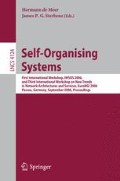Abstract
The usage of peer-to-peer networks often follows a query-response paradigm, where users initiate searches which then have to be routed over the network efficiently. This paper proposes an approach for self-organizing information distribution in peer-to-peer networks that inverts this paradigm: data objects actively travel through the net to those nodes for which they are relevant. The underlying mechanism is rooted in the principles of Swarm Intelligence and relies on the dissemination of artificial pheromones, where each pheromone represents one particular relevance criterion that applies to a given data object. Data objects leave trails of these pheromones at each node they visit and move along gradients of pheromone concentration to regions in which they are relevant.
Access this chapter
Tax calculation will be finalised at checkout
Purchases are for personal use only
References
Kennedy, J., Eberhart, R.C.: Swarm Intelligence. Morgan Kaufmann Publishers, San Francisco (2001)
Resnick, M.: Turtles, Termites, and Traffic Jams. The MIT Press, Cambridge (2001)
Charles, A., Menezes, R., Tolksdorf, R.: On the Implementation of Swarm Linda. In: ACM-SE 42: Proceedings of the 42nd Annual Southeast Regional Conference, pp. 297–298. ACM Press, New York (2004)
Dorigo, M., Di Caro, G.: The Ant Colony Optimization Meta-Heuristic. In: Corne, D., Dorigo, M., Glover, F. (eds.) New Ideas in Optimization, pp. 11–32. McGraw-Hill, New York (1999)
Michlmayr, E., Pany, A., Kappel, G.: Using Taxonomies for Content-based Routing with Ants. In: Proceedings of the 2nd Workshop on Innovations in Web Infrastructure (2006)
Diaz-Aviles, E., Schmidt-Thieme, L., Ziegler, C.-N.: Emergence of Spontaneous Order Through Neighborhood Formation in Peer-to-Peer Recommender Systems. In: Proceedings of the 1st Workshop on Innovations in Web Infrastructure (2005)
Author information
Authors and Affiliations
Editor information
Editors and Affiliations
Rights and permissions
Copyright information
© 2006 Springer-Verlag Berlin Heidelberg
About this paper
Cite this paper
Handt, A. (2006). Proposal for Self-organizing Information Distribution in Peer-to-Peer Networks. In: de Meer, H., Sterbenz, J.P.G. (eds) Self-Organizing Systems. EuroNGI IWSOS 2006 2006. Lecture Notes in Computer Science, vol 4124. Springer, Berlin, Heidelberg. https://doi.org/10.1007/11822035_20
Download citation
DOI: https://doi.org/10.1007/11822035_20
Publisher Name: Springer, Berlin, Heidelberg
Print ISBN: 978-3-540-37658-3
Online ISBN: 978-3-540-37669-9
eBook Packages: Computer ScienceComputer Science (R0)

